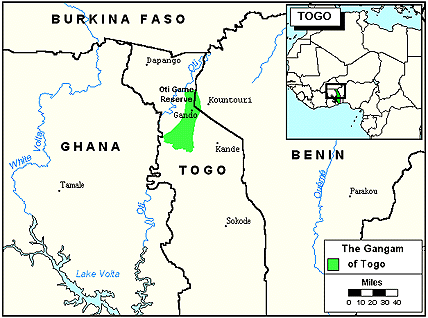The Gangam are one of the Sudanic peoples who live in northern Togo, south of the mountainous zone of the Dapango region. They also live in and around the towns of Gando, Mogou, and Kountouri and along the coasts of Ghana and Benin. Gando is considered the center of economic and religious life for the Gangam. In this northern area, dry, dusty plains alternate with well-watered grasslands, where many game animals are still found. Because of the expansion of a game reserve in the region, the Gangam have lost large tracts of land, forcing some to move to other areas.
The Gangam speak Ngangam, a Gur language closely related to Gurma. Because many Anufo villages are also located in the area, many Gangam have learned to speak the Anufo language as well. They are closely related in language and culture to the Moba and the Konkomba. The Gangam are also considered to be a part of the Bimoba people, and many classify them as a sub-group of the Bimoba.
The Gangam make their living by raising cattle or camels and through subsistence agriculture. The main farms are located in the bush, away from the villages. Crops grown there include millet, guinea corn, groundnuts, beans, peppers, and potatoes. Small farms are also located around the compounds where early millet, okra, and maize are grown. During the dry season, the bush is burned and wild guinea fowl, rabbits, and other game are hunted. Game is consumed by the family, sold in the market, or dried and smoked for later consumption or sale. Aside from cattle or camels, a family may own pigs, sheep, and goats. Pigs are raised primarily by the women and are used for social functions such as marriages, funerals, and initiation ceremonies. Cows are used mainly for sacrifice. Nuts and fruits are collected in the bush and are occasionally sold in the markets. Baskets, mats, and fans-all made from palm leaves-are among the crafts they produce. The area's main markets are in the larger towns and cities, and bring in traders from outside the region
The Gangam live in villages that are divided into compounds. Each compound houses a man, his wives, and children, or a man, his sons, and their wives and children. An average compound has about 12 rooms or huts that circle around a central interior courtyard and kitchen. Most huts are round with thatched roofs. Many compounds have one rectangular hut made of metal sheets where the eldest member in the family sleeps.
Gangam children go through a rite of initiation known as koont or "rebirth." For a three month period, they are taken away from the villages to live in huts specially constructed of mats. They are given new names to mark their entry into adulthood. The initiation promotes unity among the children and prepares them for their common life in the village where they will help each other socially, politically, and economically. Rites and dancing mark the end of the three months and the end of their childhood. Although it is still practiced, the koont is slowly losing its significance.
The majority of the Gangam follow their traditional ethnic beliefs and practices. They believe in a supreme god and creator who will judge and render punishment after death. Each family has its own shrine where it worships and sacrifices to the family gods. The worship of ancestral spirits is also very important in Gangam religion.
Soothsayers are believed to be able to tell a person why he or she is sick and offers advice regarding the sacrifice required to cure the sickness. They also identify the sacrifices needed to appease the spirits in times of poor harvest and other disasters.
The Gangam have some Christian resources available to them. Most have not had an opportunity to hear a clear presentation of the Gospel. Much evangelistic work and prayer are needed to help the Gangam know of a true Savior.
Ask the Lord of the harvest to send forth laborers to work among the Gangam.
Ask God to raise up prayer teams who will break up the soil through worship and intercession.
Ask the Holy Spirit to grant wisdom and favor to missions agencies focusing on the Gangam.
Pray that God will give Gangam believers boldness to share Christ with their own people.
Ask the Holy Spirit to complete the work begun in the hearts of the Gangam believers through adequate discipleship.
Ask the Lord to bring forth a strong Gangam church for the glory of His name!
Scripture Prayers for the Gangam in Togo.
| Profile Source: Bethany World Prayer Center |











